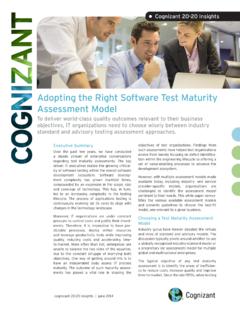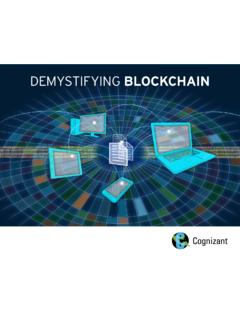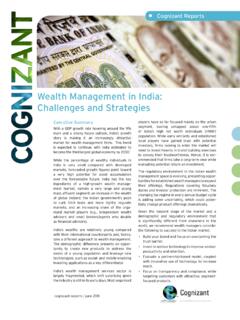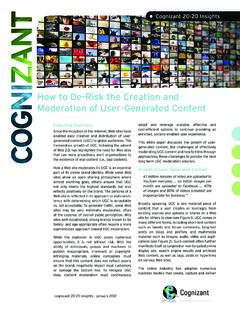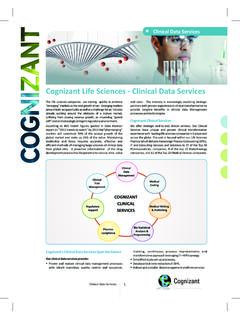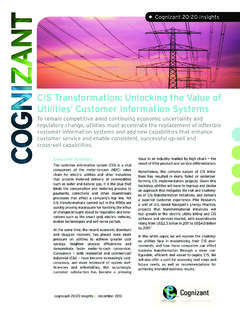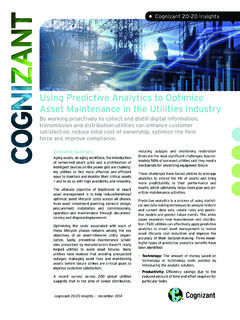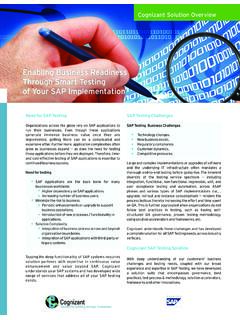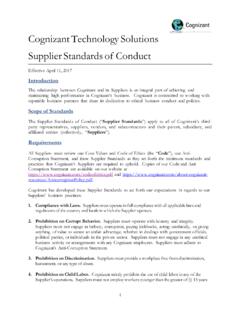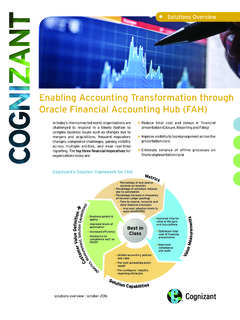Transcription of Legacy Enterprise Systems Modernization: Five Ways of ...
1 Cognizant 20-20 Insights Legacy Enterprise Systems modernization : five ways of Responding to Market Forces Whether your organization replaces the entire Enterprise application system , replaces one application/component at a time, applies localized fixes in one application or modernizes underlying infrastructure, any approach is typically better than none at all. Executive Summary Market forces demand a response from companies Hence, many companies now realize that they in every corner of the world seeking to maintain must transform their IT Systems with a modern a modern and effective Enterprise information technology stack or risk irrelevance.
2 Environment. Whether it is consumerism, digitiza- tion, social-mobile-analytics-cloud (aka the SMAC However, how they approach this transformation Stack) or productization, the organizations that depends on factors such as their organizational run business IT Systems must be agile enough culture, scope, urgency, risk appetite, existing to respond to market demands in better faster technology stack, technical expertise, program cheaper ways . management maturity, funding availability, etc. However, not all Legacy Enterprise applica- This white paper describes the five ways we have tions many of which were built on decades- seen companies approach Legacy moderniza- old technology and use architectures that were tion, four of which, if done right, can keep them in built when IBM mainframes still ruled can the competition.
3 Support the continuously accelerating pace of business change. cognizant 20-20 insights | july 2015. modernization Approaches 1 TOTAL TRANSFORMATION KEY COMPONENTS. OUT DB. Old Technology &. Platform IN Rules New Technology &. Platform UI. 2 GRADUAL REPLACEMENT. Process Component by Component modernization Reports Integration 3 DUCT TAPE APPROACH. Small Fixes with New Technology 4 IMPROVE EXISTING. Redesign Legacy for Efficiency 5 NO system CHANGE. Watching Others Complete Old Complete New Changed with Changed with Technology Technology New Technology Old Technology Figure 1.
4 Cognizant 20-20 insights 2. five ways of modernization 1 TOTAL TRANSFORMATION. Approach: The entire system is rebuilt using new technology, and the old system is sunsetted. It is built from scratch using standard platforms ( , J2EE) or built using a third-party package as a foundation layer. Example End-to-end healthcare claims system replaced with a new claims package. Applicable Current age-old system cannot support additional changes needed by the market. Situations Underlying technology platform is no longer supported by the vendor. Current technology is expensive to license.
5 Other companies are moving to a less expensive stack (often open source). Post-mergers/acquisitions, the company needed to build a new application with unified functionality. New leadership was pursuing a new IT vision to support aggressive business goals. Benefits Provides the highest return and best competitive edge over competitors. Technology stack and architecture is modern enough to remain competitive for several years into the future. Offers the maximum flexibility in architecture and design and is not constrained by old components.
6 Operational measures, SLAs/KPIs, business effectiveness and efficiency all receive a huge boost. Offers an excellent opportunity to redefine/improve the business processes leveraging new Systems . Success Proper due diligence/assessment must be conducted when selecting the technology. Factors Assessment phase to define roadmap with key milestones ( , go-live dates). Iterative roll-out to minimize the volume and impact of change (compared to big-bang go-live). Stakeholder management with regular communication and end-user training and acceptance.
7 Strong program management and governance practices must be followed. Production parallel execution ( parallel adoption ) and comparison of old and new Systems . Understanding the data structure and data quality if data migration is involved. Capture and validate the nonfunctional requirements ( , availability, performance, etc.). IT department's ability to learn the new technology and augment it with outside talent if needed. Risks This is the most risky, yet most rewarding approach. Entire functionality is at stake and any quality issue can impact the business operations.
8 Likelihood of failure or midway stop/hold is highest due to cost overruns or missed deadlines. Pockets of resistance by end users due to inability to handle/accept the change. Business sponsor may become demotivated if no incremental business benefits are demonstrated. Verdict This is the best option if done properly, as it takes the Systems far ahead of competi- tors. But only organizations with the required IT capability and maturity should go this route. cognizant 20-20 insights 3. 2 GRADUAL REPLACEMENT. A component/functional block of an IT system is replaced with a new technology and moved to production as a separate application while the rest of the system remains on old technology.
9 With time, remaining components/functional blocks are replaced with separate apps and gradually the entire system is rebuilt. Example Claims accumulator functionality ( , for calculating deductibles, etc.) is taken out of an end-to-end Legacy claims Systems and built as a separate application. Situations Replace entire Systems one component at a time, with controlled release of budget. Only a few components contribute to most of the issues. Externalize and consolidate scattered business rules using business rule management system (BRMS) platform.
10 Eliminate tight coupling of the Systems by implementation of Enterprise service bus (ESB). Change the existing Systems from batch to real-time/online. Build service wrapper on top of the existing Systems to provide the data to other Systems . Modernize flat files or outdated database Systems using leading RDBMS Systems . Replace Legacy dumb terminals with new UI, supporting Internet browser and mobile devices. Reduce license cost by implementing an open source platform. Benefits This is a low-risk way to transform the entire system by moving one piece at a time.
